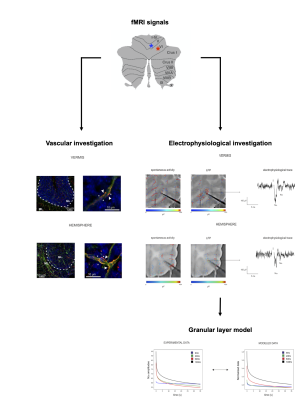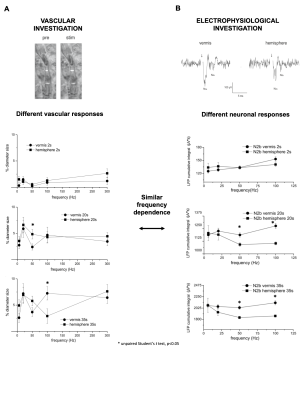Anita Monteverdi1,2, Giuseppe Gagliano2, Stefano Casali2, Fulvia Palesi1,2, Claudia AM Gandini Wheeler-Kingshott 1,2,3, Lisa Mapelli2, and Egidio D'Angelo1,2
1Brain Connectivity Center Research Department, IRCCS Mondino Foundation, Pavia, Italy, 2Brain and Behavioral Sciences, University of Pavia, Pavia, Italy, 3Queen Square MS Centre, Department of Neuroinflammation, UCL Queen Square Institute of Neurology, Faculty of Brain Sciences, University College London, London, United Kingdom
1Brain Connectivity Center Research Department, IRCCS Mondino Foundation, Pavia, Italy, 2Brain and Behavioral Sciences, University of Pavia, Pavia, Italy, 3Queen Square MS Centre, Department of Neuroinflammation, UCL Queen Square Institute of Neurology, Faculty of Brain Sciences, University College London, London, United Kingdom
Our results show for the first time the region-specificity and frequency-dependency of the neurovascular coupling in the cerebellar cortex, combining vascular time-lapse bright-field imaging, electrophysiological investigations ex vivo, and computational models of neuronal activity.

Fig.1| Cerebellar vermis and hemisphere showed different fMRI signals in humans in vivo1,2. In order to explore the neurophysiological basis of such difference we characterized capillary responses ex-vivo in vermis lobule V and hemisphere lobule VI in acute mouse cerebellar slices (left: vascular organization of these regions) and recorded neuronal activity with an HD-MEA (right: LFP signals recorded from the granular layer). Then, we validated a biophysical realistic model with the electrophysiological data and used it to dissect the neuronal contribution to the NVC.

Fig. 2| Capillary dilation differed between cerebellar vermis and hemisphere in response to mossy fibers stimulation, and vascular responses did not show linear trends while increasing the input frequency. Granular layer neuronal responses recorded as Local Field Potentials (N2a-N2b peaks) differed in cerebellar vermis and hemisphere, and the N2b peak presented a non-linear frequency dependent trend. Importantly N2b peak is informative of N-methyl-D-aspartate receptors (NMDA) activation and the NMDAR-NO pathway is known to regulate cerebellar neurovascular coupling3.